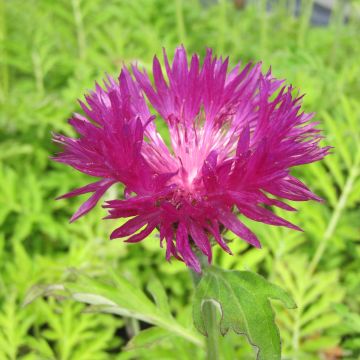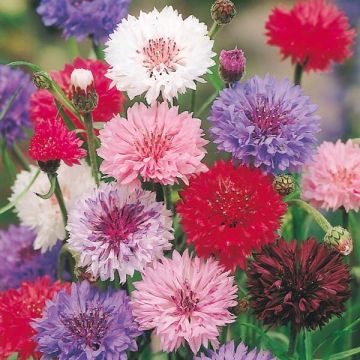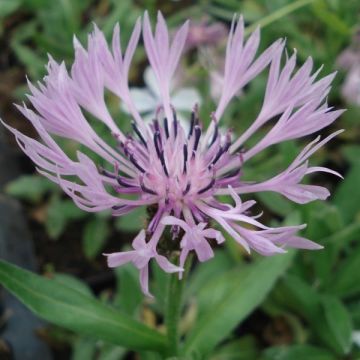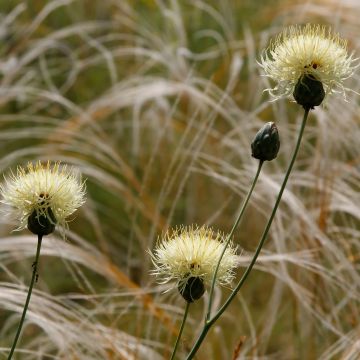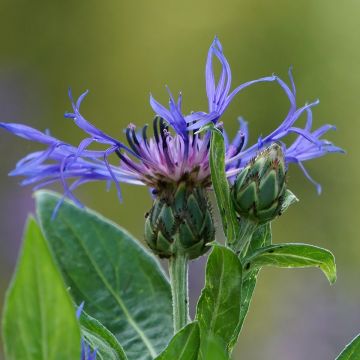

Centaurea montana Caramia
Centaurea montana Caramia
Centaurea x montana Caramia
Hybrid knapweed, Mountain bluet, Mountain bornflower, Perennial bornflower, Great blue-bottle
Why not try an alternative variety in stock?
View all →This plant carries a 12 months recovery warranty
More information
We guarantee the quality of our plants for a full growing cycle, and will replace at our expense any plant that fails to recover under normal climatic and planting conditions.
From €5.90 for pickup delivery and €6.90 for home delivery
Express home delivery from €8.90.
Does this plant fit my garden?
Set up your Plantfit profile →
Description
Centaurea 'Caramia' is part of these new hybrids of mountain cornflower that revisit this robust perennial so widespread in gardens. The fringed flowers of 'Caramia' are true pink cornflowers and beautifully swirling. They bloom in large numbers from late spring and continue throughout summer if the soil remains moist and faded flowers are removed. The reputation of the mountain cornflower is well established: it grows everywhere, in heavy or light soils, in the sun or in partial shade. Once out of fashion, it is making a strong comeback with new colours that are hard to resist!
Spontaneous in the mountains of Europe, Centaurea montana is an herbaceous perennial plant of the Asteraceae family. It develops from trailing rhizomes. This medicinal and ornamental plant has been cultivated for a long time in all gardens where it self-seeds spontaneously. It prefers limestone and clayey soil with a rocky tendency. Its deciduous foliage falls in winter. Through hybridisation with other species, it has created many interesting varieties, such as 'Caramia'.
'Caramia' has foliage that differs slightly from that of the mountain cornflower: it is less hairy and slightly less grey. The plant forms bushy clumps, 50 to 60cm (20 to 24in) tall when in bloom (30cm (12in) for the foliage), and at least 40cm (16in) wide. Its upright stems carry leaves that are 5 to 6cm (2in) long, lanceolate in shape, with entire margins, and a green colour tinged with grey. Flowering takes place from spring to summer, lasting 2 to 3 months, earlier or later depending on the region. The decorative, dark brown floral bud is a head composed of tightly packed bracts, resembling a small artichoke. The originality of this selection lies in the appearance of the inflorescences, which are pink and swirling. These are large heads approximately 5cm (2in) in diameter, with a deep pinkish-purple centre, surrounded by longer florets, divided into slender lobes, of a lighter mauve-pink hue. It is a nectar-producing plant that produces high-calorie pollen, greatly appreciated by pollinating insects, especially bumblebees.
Centaurea 'Caramia' is a perfect perennial in a countryside setting or in a naturalistic bed. Highlight it against a background of Allium azureum. An historic ally of wild and romantic gardens, the mountain centaury is also highly appreciated in more contemporary compositions. It is well suited to a rock garden, where it can accompany helianthemums and Centranthus ruber. 'Caramia' pairs wonderfully with the blue flowers of the species, scabious, small thistles (Echinops ritro), or even the incredible blue of the wild chicory. It can also be accompanied by small grasses like Stipa or golden-leaved carex. It will find its place in a rock garden, and at the edge of beds, paths, or lawns. It can be used to create lovely countryside bouquets or to dry its long-lasting heads for decoration.
Centaurea montana Caramia in pictures


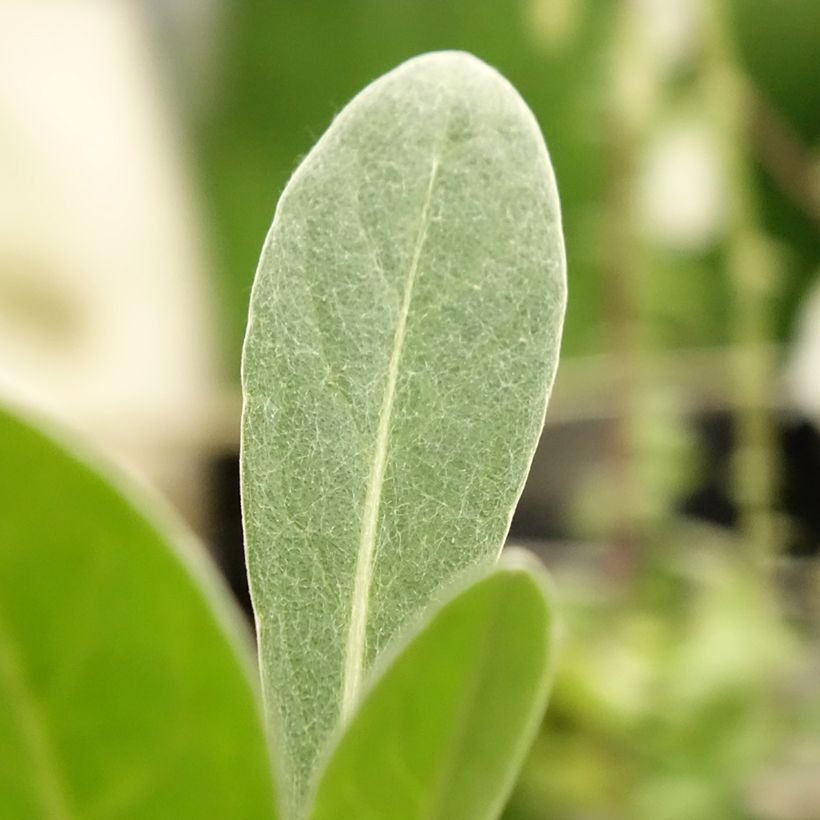

Flowering
Foliage
Plant habit
Botanical data
Centaurea
x montana
Caramia
Asteraceae
Hybrid knapweed, Mountain bluet, Mountain bornflower, Perennial bornflower, Great blue-bottle
Cultivar or hybrid
Other Centaurea
Planting and care
Plant in ordinary, well-drained soils, even clayey, calcareous, or poor ones. Place in full sun or partial shade. It tolerates heavy and moist soils but prefers rocky and well-drained soils. Periodically dry soils in summer simply make it disappear until the return of rain. Water it generously at planting and maintain regular watering during the first 8 weeks. After flowering, prune the flower stalks to the ground, allowing for a late summer flowering comeback.
It is sensitive to powdery mildew in summer. As soon as the foliage is affected (covered in "white"), after an initial flowering, prune the plant close to the ground. After a few waterings, new foliage and a second flowering will develop.
Planting period
Intended location
Care
This item has not been reviewed yet - be the first to leave a review about it.
Spring flowering perennials
Haven't found what you were looking for?
Hardiness is the lowest winter temperature a plant can endure without suffering serious damage or even dying. However, hardiness is affected by location (a sheltered area, such as a patio), protection (winter cover) and soil type (hardiness is improved by well-drained soil).

Photo Sharing Terms & Conditions
In order to encourage gardeners to interact and share their experiences, Promesse de fleurs offers various media enabling content to be uploaded onto its Site - in particular via the ‘Photo sharing’ module.
The User agrees to refrain from:
- Posting any content that is illegal, prejudicial, insulting, racist, inciteful to hatred, revisionist, contrary to public decency, that infringes on privacy or on the privacy rights of third parties, in particular the publicity rights of persons and goods, intellectual property rights, or the right to privacy.
- Submitting content on behalf of a third party;
- Impersonate the identity of a third party and/or publish any personal information about a third party;
In general, the User undertakes to refrain from any unethical behaviour.
All Content (in particular text, comments, files, images, photos, videos, creative works, etc.), which may be subject to property or intellectual property rights, image or other private rights, shall remain the property of the User, subject to the limited rights granted by the terms of the licence granted by Promesse de fleurs as stated below. Users are at liberty to publish or not to publish such Content on the Site, notably via the ‘Photo Sharing’ facility, and accept that this Content shall be made public and freely accessible, notably on the Internet.
Users further acknowledge, undertake to have ,and guarantee that they hold all necessary rights and permissions to publish such material on the Site, in particular with regard to the legislation in force pertaining to any privacy, property, intellectual property, image, or contractual rights, or rights of any other nature. By publishing such Content on the Site, Users acknowledge accepting full liability as publishers of the Content within the meaning of the law, and grant Promesse de fleurs, free of charge, an inclusive, worldwide licence for the said Content for the entire duration of its publication, including all reproduction, representation, up/downloading, displaying, performing, transmission, and storage rights.
Users also grant permission for their name to be linked to the Content and accept that this link may not always be made available.
By engaging in posting material, Users consent to their Content becoming automatically accessible on the Internet, in particular on other sites and/or blogs and/or web pages of the Promesse de fleurs site, including in particular social pages and the Promesse de fleurs catalogue.
Users may secure the removal of entrusted content free of charge by issuing a simple request via our contact form.



































